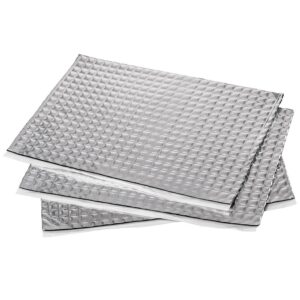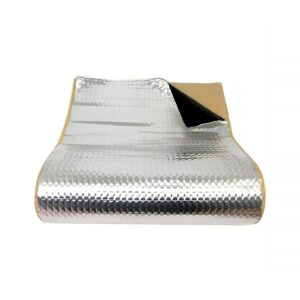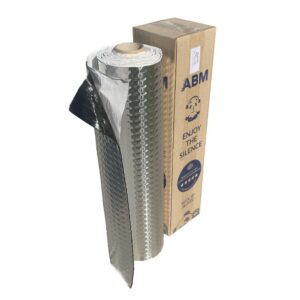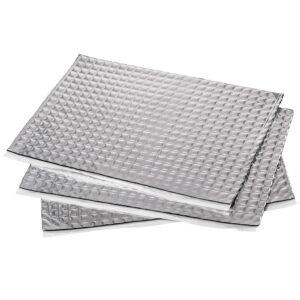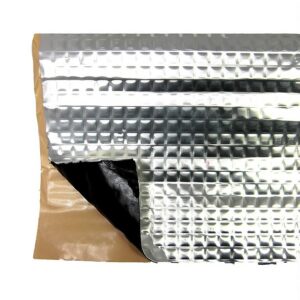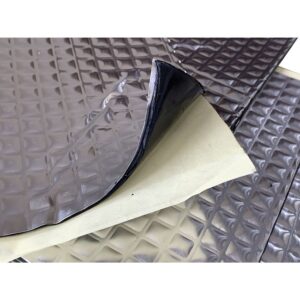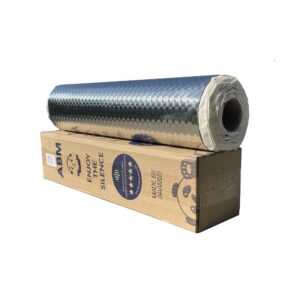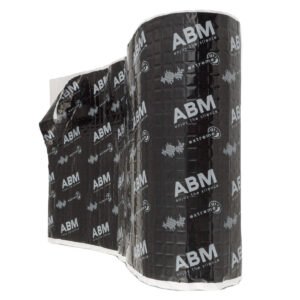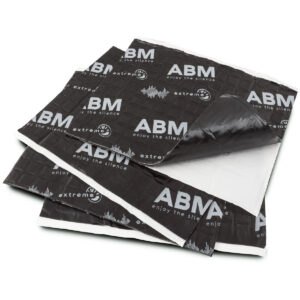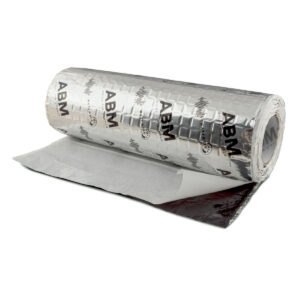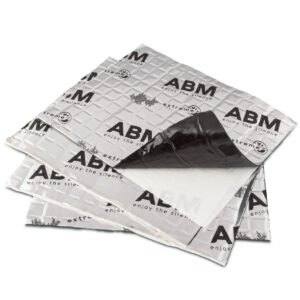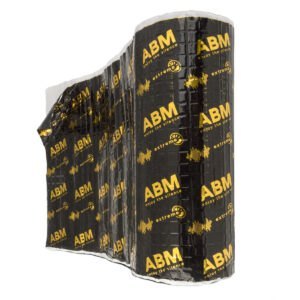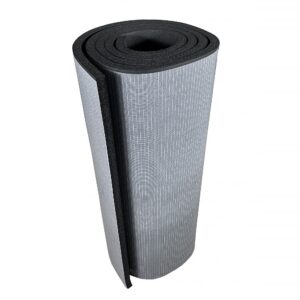Every yacht or motorboat owner knows how annoying noise can be during the sailing season. Engine vibrations, the sound of water hitting the hull, and other noises significantly affect the comfort of relaxation on the water. Effective soundproofing of a vessel requires a thoughtful approach and the use of appropriate insulation materials. Proper acoustic insulation not only increases crew comfort but also protects structural elements from vibrations.
Preparing a yacht for the season involves many technical and maintenance tasks. One of the most important elements is installing or replacing soundproofing materials. During winter, insulation components can degrade due to moisture and temperature fluctuations. Therefore, each sailing season should begin with a thorough inspection of the soundproofing system. Professionally executed acoustic insulation can reduce noise levels by up to 70% compared to an uninsulated vessel.
Effective soundproofing requires knowledge of the properties of various materials and skills in their proper installation. Modern insulation solutions allow excellent results with relatively low financial outlays. The key to success is selecting the right products and applying them in strategic locations on the boat or yacht.
Soundproofing Materials for Yachts and Motorboats
Choosing the right insulation materials is fundamental to effective soundproofing of a vessel. Modern technological solutions offer a wide range of products with different properties and applications. Each material has unique features that make it suitable for specific uses on a boat or yacht.
Butyl Mats as the Basis of Insulation
Butyl mats are among the most effective soundproofing materials available in the marine market. They are characterized by excellent vibration damping properties and high resistance to marine conditions. The butyl structure provides long-lasting protection against corrosion and saltwater exposure.
The thickness of butyl mats ranges from 2 to 8 millimeters. Thinner versions work perfectly in areas with limited installation space. Thicker mats provide better insulation but require more room for installation. The operating temperature range for butyl mats is from -40 to +80 degrees Celsius.
The adhesive properties of butyl allow easy installation on various metal surfaces. The material adheres well to steel, aluminum, and plastics. The mat’s flexibility enables it to conform to curved hull surfaces without losing insulating properties.
Butyl also shows excellent resistance to oils, fuels, and chemicals used on boats. This property makes butyl mats ideal for insulating engine compartments. The material does not absorb water and does not degrade under moisture exposure.
Rubber Foams in Insulation Systems
Rubber foams represent the second basic solution in soundproofing vessels. The cellular structure of foam provides excellent absorption of sounds at various frequencies. The material features low density, which is important for boat stability.
The thickness of rubber foams ranges from 10 to 50 millimeters. Greater thickness provides better sound insulation but also increases the unit’s weight. Foams with a thickness of 20-30 millimeters are the optimal solution for most applications on yachts and motorboats.
Rubber foams exhibit excellent resistance to marine conditions. The closed-cell structure prevents water absorption as well as the growth of mold and fungi. The material retains its insulating properties even after years of use in harsh conditions.
Types of foams by application:
- Standard foams – for basic living space insulation
- Self-adhesive foams – facilitate installation in hard-to-reach places
- Flame-retardant foams – required in engine compartments
- Foams with increased thickness – for engine room noise reduction
The operating temperature range of rubber foams spans widely from -50 to +105 degrees Celsius. The material’s flexibility allows installation on surfaces with complex shapes. Foams can be combined with butyl mats to create multilayer insulation systems.
Composite and hybrid materials
Modern composite materials combine the properties of various components into a single product. Hybrid systems consist of a vibration-damping layer and an absorptive layer. This solution provides comprehensive acoustic protection while minimizing installation thickness.
The butyl layer in composite materials is responsible for damping mechanical vibrations. The foam layer absorbs airborne sounds at different frequencies. The combination of both layers ensures noise reduction in the range of 15-25 decibels.
Composite materials feature easier installation through the use of self-adhesive layers. This eliminates the need for additional adhesives or mechanical fasteners. The total thickness of composite systems typically ranges from 15 to 25 millimeters.
The advantages of hybrid materials also include increased durability and resistance to external factors. The outer layer protects the internal structure from water and chemical agents.
The best locations for installing acoustic insulation on a yacht
The strategic selection of locations for installing insulation materials determines the effectiveness of the entire soundproofing system. Different areas of the yacht generate different types of noise and require specialized approaches. Analyzing sound sources allows optimizing material placement while maintaining project cost efficiency.
Professional acoustic insulation requires understanding the mechanisms of sound transmission on a vessel. Noise spreads through the hull structure, equipment components, and air within cabins.
The engine compartment as a priority
The engine room is the main source of noise on every motorboat or yacht. The main engine, generator, pumps, and ventilation systems generate vibrations and sounds that transmit throughout the entire structure. Proper insulation of this area can reduce noise levels in cabins by up to 50%.
Engine room walls require coverage with butyl mats at a minimum thickness of 4 millimeters. The material should be applied directly to the metal surfaces of the hull. Special attention must be paid to the engine mounting points and other mechanical equipment.
The engine room ceiling needs an additional layer of rubber foam with a thickness of 30-40 millimeters. The foam should be mechanically fastened due to gravity. The fastening systems must be resistant to vibrations and high temperatures.
The engine room floor requires a special approach due to potential contact with fuel and oils. Butyl mats with increased thickness of 6-8 millimeters provide adequate protection. The surface must be thoroughly cleaned before installing the materials.
Living cabins and recreational spaces
Living cabins require materials with high absorption properties. Rubber foams with a thickness of 20-25 millimeters work perfectly on cabin walls and ceilings. Materials should have an aesthetic finish or be concealed under decorative panels.
Cabin floors need a combination of butyl mats and rubber foams. The butyl layer dampens vibrations transmitted through the hull structure. The foam layer improves acoustic comfort and thermal insulation.
Elements requiring special attention:
- Areas around windows – potential acoustic leakage points
- Panel joints – require sealing with insulating gaps
- Installation passage points – need special seals
- Surfaces near beds – direct contact with users
Cabin insulation must consider space ventilation. Materials cannot block airflow or create moisture accumulation spots. Proper ventilation gaps prevent mold and mildew issues.
Tip: Before installing foams in living cabins, verify that the materials have fire safety certificates required on floating units.
Hull and cargo spaces
The yacht hull transmits sounds originating from wave impacts and propulsion system operation. Insulating the internal surfaces of the hull significantly improves the acoustic comfort of the entire vessel. Butyl mats should be applied to larger flat surfaces of the sides.
Cargo spaces often act as resonators amplifying noise. Lining these spaces’ walls and floors with butyl mats eliminates unwanted sound reflections. Material thickness can be less than in the engine room—2-3 millimeter mats are sufficient.
Areas mounting deck equipment are particularly prone to vibration transmission. Additional layers of damping materials should be applied around these points. Butyl mats with increased thickness prevent vibration transfer to the structure.
The connections between hull sections require special acoustic seals. Materials must be flexible and resistant to seawater exposure.
Step-by-step Installation Instructions for Butyl Mats on a Boat
Proper installation of insulation materials requires careful surface preparation and adherence to a specific sequence of steps. Each stage of the installation is crucial for the final effectiveness of the soundproofing system. Mistakes made during installation can significantly reduce the acoustic insulation performance.
Preparing the right tools and materials facilitates the work and ensures a professional result. Weather conditions during installation affect the adhesive properties of the insulation materials.
Surface Preparation for Installation
Thorough surface preparation is the foundation for a durable bond between the insulation materials and the boat structure. Metal surfaces require removal of all contaminants, rust, and old protective coatings. The cleaning process can be done mechanically or chemically.
Mechanical cleaning involves sanding with 120-240 grit sandpaper. This process removes surface irregularities and increases material adhesion. Dust generated during sanding should be thoroughly removed with compressed air or an industrial vacuum cleaner.
Degreasing the surface is another key preparatory step. Using solvents such as acetone or isopropanol ensures removal of residual oils and greases. The surface must be completely dry before applying the butyl mats.
The surface temperature during installation should be between 15-25 degrees Celsius. Too low a temperature reduces butyl’s adhesive properties. Too high a temperature may cause the glue to cure too quickly, making it difficult to position the materials.
Measuring and Cutting Materials
Accurate measurement of areas designated for insulation allows optimal use of materials. A cardboard or paper template helps transfer complex shapes onto butyl mats. Leave a 2-3 centimeter margin for final adjustments.
Cutting butyl mats requires sharp tools due to the material’s hardness. A utility knife with a new blade or tin snips provide clean cuts without fraying. The cutting line should be straight and even for an aesthetically pleasing final appearance.
Tools necessary for installation:
- Utility knife – for precise mat cutting
- Pressure roller – eliminates air bubbles
- Plastic spatula – smooths material surface
- Tape measure and pencil – for marking cutting lines
- Degreaser – surface preparation
- Protective gloves – safe handling of materials
Room temperature materials are easier to shape and adhere to surfaces. Mats stored at low temperatures should be left in a warm place for several hours before installation.
The order of mat application should consider accessibility of specific areas. Hard-to-reach spots should be insulated first before being partially covered by other equipment components.
Application and Pressing Technique
The proper technique for applying butyl mats ensures even distribution of the material without wrinkles or air bubbles. The process should start from one end and gradually move in the opposite direction. Strong pressure during application activates the adhesive properties of the butyl.
Removing the protective film should be done gradually while applying the mat. Peeling off the entire film at once can cause the material to stick together or become contaminated. Leaving small pieces of film helps with positioning and adjusting the placement.
The pressure roller should be guided from the center of the mat toward the edges. This motion eliminates air bubbles and ensures full adhesion to the surface. Pressure must be even across the entire surface of the material. Special attention should be paid to the edges and corners of the mats.
Overlap between adjacent mats should be at least 10 millimeters. Greater overlap ensures acoustic tightness of joints. Connection points require additional pressing with a roller to ensure a durable bond.
Tip: When installing in low temperatures, you can gently warm the butyl mat with a hairdryer, which will increase its flexibility and make it easier to fit curved surfaces.
Materials for Effective Soundproofing at ABM Insulation Store
ABM Insulation offers a comprehensive range of materials designed for soundproofing yachts and motorboats. The products are characterized by high-quality craftsmanship and adaptation to the specific requirements of marine environments. Each product group has been developed with specific applications in watercraft in mind.
ABM Professional Butyl Mats
The ABM Professional series is a premium solution for demanding marine applications. The materials feature an increased thickness of the butyl layer and a reinforced carrier structure. The operating temperature reaches up to 85 degrees Celsius, allowing installation near engines.
The adhesive layer of ABM Professional mats shows excellent adhesion to aluminum and steel surfaces. The material does not require additional heating during installation at temperatures above 10 degrees Celsius. The mat’s structure provides long-lasting flexibility even after years of use.
Available thicknesses for ABM Professional mats range from 2.5 to 6 millimeters. Roll widths are standard at 50 centimeters, allowing coverage of large areas with minimal seams. Roll lengths are adapted to various project needs.
ABM Professional mats have certificates confirming compliance with marine safety standards. The material does not emit harmful substances and features limited flammability. These properties are especially important in enclosed spaces on watercraft.
Butyl Soundproofing Mats ABM Professional in the ABM Insulation store
ABM Xtreme Butyl Mats
The ABM Xtreme line is designed for the most demanding operating conditions on vessels. The increased temperature resistance reaches up to 100 degrees Celsius. The material performs perfectly in engine rooms of marine diesel engines and generator spaces.
The butyl layer in ABM Xtreme mats contains additives that enhance resistance to marine fuels. The material does not degrade when exposed to gasoline, diesel fuel, or lubricating oils. This property is crucial for insulating engine compartments.
ABM Xtreme Technical Specifications:
- Available thicknesses – 3, 4, 6, and 8 millimeters
- Operating temperature – from -45 to +100 degrees Celsius
- Fuel resistance – full compliance with maritime standards
- Product lifespan – minimum 15 years in marine conditions
The surface structure of ABM Xtreme mats ensures increased mechanical adhesion. Special embossing improves contact with the mounting surface and eliminates air bubble formation. This system is especially effective on surfaces with minor irregularities.
ABM Xtreme Mats are available in a self-adhesive version as well as one requiring additional adhesives. The self-adhesive version facilitates installation in hard-to-reach areas of engine rooms.
Butyl Soundproofing Mats ABM Xtreme in the ABM Insulation store
ABM Xtreme Premium Self-adhesive Butyl Soundproofing Mat in rolls, 2.5mm, 2m2
Acoustic Butyl Mat Self-adhesive ABM Xtreme Premium in rolls, 2.0mm, 2m2
Rubber Insulation Foams
Rubber foams from ABM Insulation feature a closed-cell structure and high moisture resistance. The materials are available in various thicknesses from 10 to 50 millimeters. Each thickness is intended for specific applications on vessels.
Foams with thicknesses of 10-15 millimeters serve as an additional absorption layer in composite systems. Thinner foams easily conform to complex hull construction shapes. Installation does not require specialized tools or techniques.
Medium thicknesses of 20-30 millimeters provide a versatile solution for living cabins. The material offers excellent sound insulation while maintaining moderate weight. Foams of this thickness can be combined with butyl mats in multilayer systems.
Thick foams of 40-50 millimeters are designed for soundproofing engine rooms and spaces with high noise levels. Increased thickness ensures maximum absorption of high-energy sounds. The material requires mechanical fastening due to its own weight.
All ABM Insulation rubber foams have a closed-cell structure. This property prevents seawater absorption and microorganism growth. The material retains its insulating properties even under high humidity conditions.
Rubber foams can be cut with a regular kitchen knife, which greatly facilitates fitting the material to unusual shapes on the boat.
Insulation Rubber Foams in the ABM Insulation store
Soundproofing rubber foam with aluminum foil ABM – 10mm, 1m2
Choosing the Optimal Thickness and Type of Rubber Foam
Selecting the appropriate thickness of rubber foam requires analyzing the specific acoustic conditions on the vessel. Different areas of the boat generate different sound frequencies and require a tailored approach. Foam that is too thin will not provide effective insulation, while foam that is too thick can cause installation issues.
The absorption properties of rubber foams depend on their cellular structure and material density. Higher density foams better dampen low frequencies but are heavier and more expensive.
Analysis of Noise Frequencies on the Vessel
Noise on a boat consists of various frequency components that require different insulation approaches. Low frequencies from 50-200 Hz mainly come from the engine and propulsion system. Mid frequencies from 200-2000 Hz are generated by pumps, fans, and wave impacts on the hull.
High frequencies above 2000 Hz originate from airflow, electronic equipment operation, and sounds from outside the vessel. Each frequency range requires materials with suitable absorption properties for effective reduction.
Foams with a thickness of 10-15 millimeters effectively absorb high frequencies. The fine cell structure provides good absorption of short wavelength sounds. Materials of this thickness are suitable for cabins and living areas.
Medium thicknesses of 20-30 millimeters cover a wide frequency range from 200 to 4000 Hz. Their versatility makes them a popular choice for most areas on the vessel. The efficiency-to-cost ratio is optimal for this thickness category.
Foam Density and Insulation Effectiveness
The density of rubber foam directly affects its acoustic and mechanical properties. Foams with densities of 30-50 kg/m³ feature good flexibility and ease of installation. These materials are suitable for applications requiring frequent disassembly.
Medium-density foams of 50-80 kg/m³ provide better sound absorption while maintaining moderate weight. The cellular structure is more uniform, resulting in predictable acoustic properties. This category represents a compromise between effectiveness and practicality.
Comparison of Properties for Different Foam Densities:
| Density (kg/m³) | Low Frequency Absorption | High Frequency Absorption | Mass (kg/m²) | Relative Cost |
|---|---|---|---|---|
| 30-50 | Average | Good | 0.3-0.5 | Low |
| 50-80 | Good | Very Good | 0.5-0.8 | Medium |
| 80-120 | Very Good | Excellent | 0.8-1.2 | High |
High-grade foams with a density of 80-120 kg/m³ provide the best acoustic insulation. Increased mass translates into better damping of mechanical vibrations. These materials are recommended for engine rooms and areas with very high noise levels.
The cellular structure of high-grade foams is more uniform and durable. The material retains its properties over a longer service life. Compression resistance is higher, preventing degradation in areas of mechanical stress.
Special Requirements of the Marine Environment
The marine environment places special demands on insulation materials due to exposure to moisture, salt, and temperature fluctuations. Rubber foams must demonstrate resistance to corrosion and aging processes. The closed-cell structure prevents seawater penetration.
UV resistance is important for foams installed near windows or skylights. Materials without proper protection may degrade under sunlight exposure. High-quality foams contain UV stabilizers within their structure.
The operating temperature range of foams in marine conditions must cover a wide span from subzero values in temperate climates to high temperatures in engine rooms. Materials must maintain flexibility at low temperatures and resist deformation at high temperatures.
Antibacterial and antifungal properties are especially important in enclosed, humid spaces on vessels. High-quality foams include additives that prevent the growth of microorganisms. This feature is crucial for maintaining hygiene onboard.
Tip: When selecting rubber foam for engine rooms, check its resistance to marine fuels – not all materials retain their properties after contact with gasoline or diesel fuel.
Soundproofing the Engine and Propulsion System of a Motorboat
The engine and propulsion system are the main sources of noise and vibration on any motorboat. Effective soundproofing of these components requires a comprehensive approach involving vibration isolation, airborne noise damping, and elimination of structural resonance. Professionally executed insulation can reduce noise levels in cabins by up to 60%.
Different components of the propulsion system require specialized insulation solutions. The main engine, gearbox, drive shaft, and propeller generate noise with varying frequency characteristics.
Insulation of the Engine Block and Gearbox
The engine block is the most intense source of mechanical vibrations on a motorboat. These vibrations transfer to the hull structure through the engine mounting system. Proper isolation of mounts can reduce vibration transmission by 80%.
Flexible engine mounts made from composite materials replace rigid metal mounts. The mounts must maintain damping properties while securely fastening the power unit. High-quality materials retain elasticity throughout the engine’s lifespan.
The mounting system must account for torsional moments and axial forces during engine operation. Flexible elements must not deflect excessively under load. Designing the system requires analyzing all forces acting on the power unit during operation.
Engine insulation system components:
- Main pads – under the engine base, dampen vertical vibrations
- Side dampers – eliminate horizontal vibrations and torsional moments
- Flexible couplings – isolate the drive shaft from the gearbox
- Wire insulators – prevent vibration transmission through installations
The gearbox requires a separate insulation system due to its different vibration characteristics. High-speed gears generate vibrations at frequencies significantly higher than those of an internal combustion engine. Higher density foams better absorb these types of sounds.
The gearbox housing can be covered with butyl mats 4-6 millimeters thick. The material reduces airborne noise generated by the gears. Additionally, the mats protect against overheating of components located near the gearbox.
Exhaust and intake systems
The marine engine exhaust system is a significant source of airborne noise. High-temperature exhaust gases create turbulence generating sounds across a wide frequency spectrum. A properly designed muffler system can reduce exhaust noise by 40-50 decibels.
Marine exhaust mufflers must meet special requirements related to condensate drainage and corrosion resistance. Internal baffles in the muffler create resonance chambers tuned to dominant frequencies in the exhaust spectrum. Absorptive materials inside the muffler absorb acoustic energy.
Exhaust pipelines require thermal and acoustic insulation. High-temperature ceramic mats protect the surroundings from overheating. An outer layer of rubber foam reduces noise transmitted through pipeline walls.
The air intake system also generates noise during engine operation. The air filter acts as an intake silencer, but its effectiveness is limited. Additional resonance chambers in the intake duct significantly improve acoustic comfort.
Drive shaft and steering system insulation
The drive shaft transmits vibrations from the engine and gearbox to the propeller. A long shaft acting like a string can amplify certain frequencies through resonance. Proper shaft support and bearing insulation eliminate this issue.
The drive shaft bearings require flexible mounting elements to the hull structure. Rubber bushings isolate bearings from structural vibrations. Materials must be resistant to seawater and lubricants used in the drive system.
Hydraulic lines of the steering system can transmit vibrations between different areas of the boat. Flexible inserts at bulkhead pass-throughs eliminate vibration transmission. Cable mounts must not be rigid to avoid creating acoustic bridges.
The hydraulic pump of the steering system is an additional source of noise in the engine room. Acoustic insulation of the pump includes flexible mounting and an enclosure made of damping materials. The suction and discharge pipes require mounts that prevent resonance vibrations.
Tip: Regular lubrication of the drive shaft bearings not only extends their lifespan but also significantly reduces generated noise – a well-lubricated bearing can be up to 10-15 decibels quieter.
Seasonal preparation of acoustic insulation before launching
Preparing the acoustic insulation system for the new sailing season requires a thorough inspection of material condition as well as their regeneration or replacement. Winter storage conditions can negatively affect insulating properties, especially with temperature and humidity fluctuations. Systematic maintenance of insulation ensures its long-lasting effectiveness.
Inspection of material condition after the winter season
Systematic inspection of acoustic insulation should begin with a visual assessment of all materials’ condition. Special attention should be paid to areas exposed to moisture and extreme temperatures. Butyl mats may show signs of detachment from mounting surfaces.
Checking the adhesion of butyl mats involves gently pressing on the edges of the material. Loose sections require removal and reattachment. Surfaces under detached mats must be thoroughly cleaned and degreased before regeneration.
Rubber foams are inspected for retention of elasticity and cellular structure. The material should not show signs of crumbling, cracking, or permanent deformation. Loss of elasticity indicates aging of the material and the need for replacement.
Critical points inspection:
- Material joints – checking seal tightness at connections and repairs
- Mechanical fastening points – assessing condition of fastening elements
- Areas exposed to moisture – monitoring mold or corrosion development
- Surfaces near heat sources – checking for signs of overheating
Documenting insulation condition facilitates planning maintenance work and budgeting material costs. Photographs of problematic areas allow monitoring degradation progress in subsequent seasons.
Regeneration and replacement of components
Partial replacement of insulating materials is often more economical than complete system renovation. Local repairs allow preserving most existing insulation while restoring full effectiveness. Repair materials must be compatible with the existing system.
Regeneration of butyl mats includes cleaning surfaces and applying new patches in damaged areas. New mats should overlap old ones by at least 5 centimeters to ensure continuity of insulation. Connection points require particularly careful pressing.
Replacement of rubber foams can be carried out gradually depending on acoustic priorities. The engine room and living cabins take precedence over cargo spaces. Removal of old foams must consider potential damage to adjacent materials.
Cleaning surfaces after removing materials requires eliminating adhesive residues and protective layers. Mechanical cleaning methods can damage the mounting surface. Chemical solvents are more effective and safer for the structure.
System Optimization for the New Season
Each sailing season provides experience that allows for improving the acoustic insulation system. Areas with insufficient effectiveness can be reinforced with additional layers of materials. Analyzing noise sources helps identify spots that need improvement.
New technologies and materials may offer better solutions than those previously used. Modernizing parts of the system allows for gradual enhancement of acoustic comfort. Investments in the latest materials quickly pay off through increased user comfort.
Seasonal preparation is an opportunity to expand the insulation system to new areas of the boat. Additional cabins, cargo spaces, or recreational areas can be included in the soundproofing program. Systematic expansion of the system is more economical than a one-time comprehensive solution.
Testing the effectiveness of the renewed system allows for an objective assessment of the results of the work performed. Noise level measurements before and after regeneration document improvements in acoustic comfort. This data is useful when planning further modernizations.
Tip: The best time for maintenance work on acoustic insulation is during the dry and warm spring period, when materials are easier to install and conditions favor proper adhesive curing.
Summary
Effective soundproofing of a yacht or motorboat is a key element in preparing for the sailing season. Professionally executed acoustic insulation significantly improves comfort while on the water and protects the crew from harmful effects of prolonged noise exposure. Investing in high-quality insulating materials pays off through years of trouble-free use.
The choice of appropriate materials and their proper installation determines the final effectiveness of the entire soundproofing system. Butyl mats and rubber foams offered by ABM Insulation provide a comprehensive solution to acoustic problems on watercraft. Regular maintenance and modernization of the insulation system ensure its long-lasting effectiveness and adaptation to users’ changing needs.


